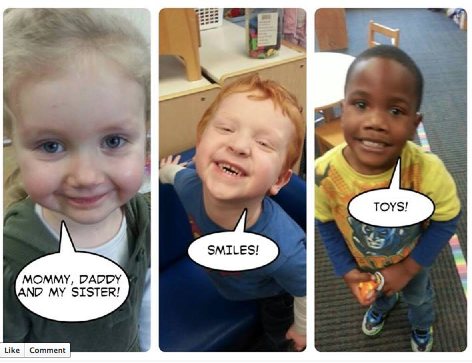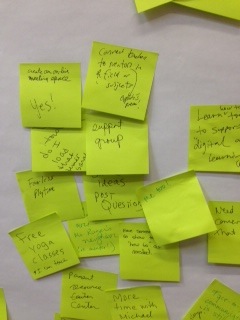JCDS started off the 2013-2014 academic year with what I would have considered a strong social media presence. While the school has been active on many social media channels for some time (Twitter, Pinterest, YouTube, LinkedIn), most of my focus had been on Facebook, as it is a quick and easy way to share photos, videos, and important updates with our parents, grandparents, donors, and alumni.
Looking back, I wasn't thinking about social media in the right way. While I posted nearly every day, the most engagement I got was a couple of likes here and there. I was posting, not connecting.
Through experimentation over the last six months, I've learned that my role, as the voice of the school on Facebook, is not to be a news source, but to create an environment that starts conversation. Once I was able to get the conversation started, Facebook became a tool unlike any other. It became a place for me to listen to what our audience values, which in the end, is the most important thing of all.
By analyzing the engagement levels and analytics of our recent posts, here are the top 5 Facebook strategies that have been successful for JCDS:
1. Tag those who are involved, and those who you want to be involved.
When you tag someone in a post or photo, it will show up on their Facebook page. Not only will it directly call attention to the person you want to be involved, but your post will also be visible to their network, and therefore, reach many more people who you otherwise would not have access to! I’ve had success asking people to tag themselves and their friends. The benefit of this is twofold: they are actively engaging with the post, and they may tag people who we are not yet connected with.
2. Ask questions.
Asking specific, pointed questions is a great way to get the conversation rolling. Sure, I’ve had a few flops, but those helped me learn what our audience likes to talk about. I've seen success in action in many of my #ThrowbackThursday posts, where I've asked (via tagging) people in the photo specific questions about what's going on in the picture. One comment leads to the next, and pretty soon anyone who sees the photo gets a deeper understanding of what was happening when the photo was taken, and hopefully feels more connected to story I am trying to tell.
3. Be genuine.
In January, JCDS students were surprised with a visit from the 2013 World Series Trophy. First, I posted that we had big news with a photo of one of our staff members dressed as a Red Sox player. The next day, I posted a photo of excited kids (and tagged their parents) and shared that the trophy would be coming. Then — the most successful post of all — was a video of a 4th grade teacher telling the kids that the trophy was coming. Seeing their pure and genuine reaction definitely resonated with our social media audience: 38 likes, 19 comments, and the jackpot, 12 shares. The video was even written about in the local newspaper, the Watertown Patch. This kind of engagement was unprecedented for us.
 4. Repeat successful themes.
4. Repeat successful themes.
Between the regular daily posts, I've committed to a few repeating themes. One universal theme, #ThrowbackThursday, has been a great way for us to connect with our alumni and alumni parents. I’ve gotten a tremendously positive response from our throwback photos. Because this is a weekly theme, the audience knows to expect it. And because there are usually a lot of comments, people are not shy to participate.
I also created a new theme, called #JCDSCharacter. I felt it was important to celebrate our students through short stories that capture the spirit of our school. Parents love to see that they are sending their kids to a school that helps them grow into mensches. It's also a great tool for prospective families. Every time a #JCDSCharacter post is shared, a whole new audience is exposed to the great things that happen in our school.
5. Engage with other organizations.
Celebrating successes of other schools and organizations is a beautiful thing! Just as much as we want people to engage with our school Facebook page, it's important to interact with others. While I am on Facebook, I make sure to take the time to look at what other organizations are posting. If they post something that relates to our school or community, I share it on our page. Fostering good-will between organizations is priceless, and the favor is almost always returned.
The Jewish Day School Social Media Academy is an intensive program designed to help Jewish Day Schools advance their strategic use of social media in areas such as communication, marketing, community building, alumni relations and development. The 2013-14 nationwide cohort of 15schools was generously supported by The AVI CHAI Foundation. Each of the schools will be sharing insights from their experience through blog posts here this spring with the tag #jdsacademy
Also, check out the Jewish Day School Social Media and Video Academy website, which includes a free self-assessment to help your school focus on key areas of growth in your social media work.





 What are you thankful for this week? I'm thankful for this catchy Facebook post from Shannon Hall and her team at the
What are you thankful for this week? I'm thankful for this catchy Facebook post from Shannon Hall and her team at the  Then, in order to attract more attention then they would have by posting the photos individually, they collaged three responses into one photo using
Then, in order to attract more attention then they would have by posting the photos individually, they collaged three responses into one photo using 
